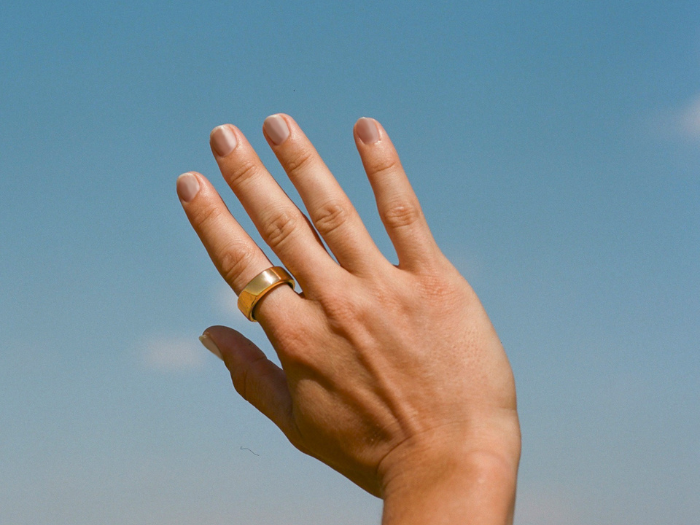What Is Your Readiness Score?
Your Readiness Score is one of three personalized Oura scores that help you answer different questions about your health:
- Your Readiness Score: How ready are you for the day?
- Your Sleep Score: How well did you sleep last night?
- Your Activity Score: How are you balancing your activity, inactivity, and rest?
Readiness is your main Oura score and is designed for you and only you, helping you discover what works for your body and lifestyle.
Readiness is a holistic picture of your health — taking into account your recent activity, sleep patterns, and direct body signals (like resting heart rate, heart rate variability, and body temperature) that can signify if your body is under strain. Your Readiness Score also influences your Resilience level.
Your Readiness Score ranges from 0-100 and tells you, at a glance, if you are ready to face greater challenges or if you need some recovery and rest:
- 85 or higher: Optimal, you’re ready for action!
- 70-84: Good, you’ve recovered well enough.
- Under 70: Pay attention, you’re not fully recovered.
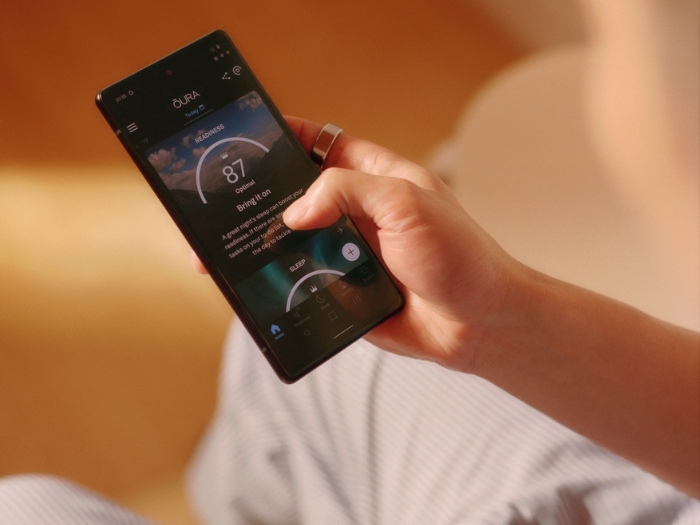
READ MORE: How Oura Measures Readiness
Your Readiness Contributors
The sum of seven daily Readiness Contributors make up your Readiness Score. Your contributors answer deeper questions about how your body is responding to your lifestyle in three core pillars – sleep, activity, and body stress.
Although you have unique Sleep and Activity Scores, your sleeping and activity levels play a strong role in your daily body status. To account for that, you have dedicated contributors that account for both your short and long-term sleep and activity levels.
Two of your Readiness Contributors account for your sleep and help you answer, “How is my sleep impacting my Readiness?”
- Sleep: “How well did I sleep last night compared to normal?”
- Sleep Balance: “Have I been getting enough sleep in the last 2 weeks?”
Two of your Readiness contributors account for your activity and help you answer: “How are my activity patterns impacting my Readiness?”
- Previous Day Activity: “Did I balance my activity, inactivity and rest yesterday?”
- Activity Balance: “How much load is my body under from my recent activity levels?”
Your remaining contributors are all dedicated to identifying signs of body stress and help you answer “Are there signs that my body needs recovery or that I may be getting sick?”
- Resting Heart Rate: “Was my RHR substantially higher or lower than usual?”
- HRV Balance: “How has my HRV changed over the past few weeks?”
- Body Temperature: “Is my body temperature higher or substantially lower than usual?”
- Recovery Index: “After my heart rate reached its baseline last night, how many hours of recovery sleep did I get?”
These contributors are entirely personal and are designed to help you spot signs of strain from stress, illness, injury, or another shift in your health — before you even feel anything in some cases. If your temperature is elevated, Oura will automatically alert you and give the option to use tools like Rest Mode to help you care for yourself.
Keep in mind that your Readiness Score places a unique emphasis on how your health is trending over time. While many wearables focus on today or last night, Oura believes that health is a journey for long-term balance and supports that exploration with long-term contributors: Sleep Balance, Activity Balance, and HRV Balance.
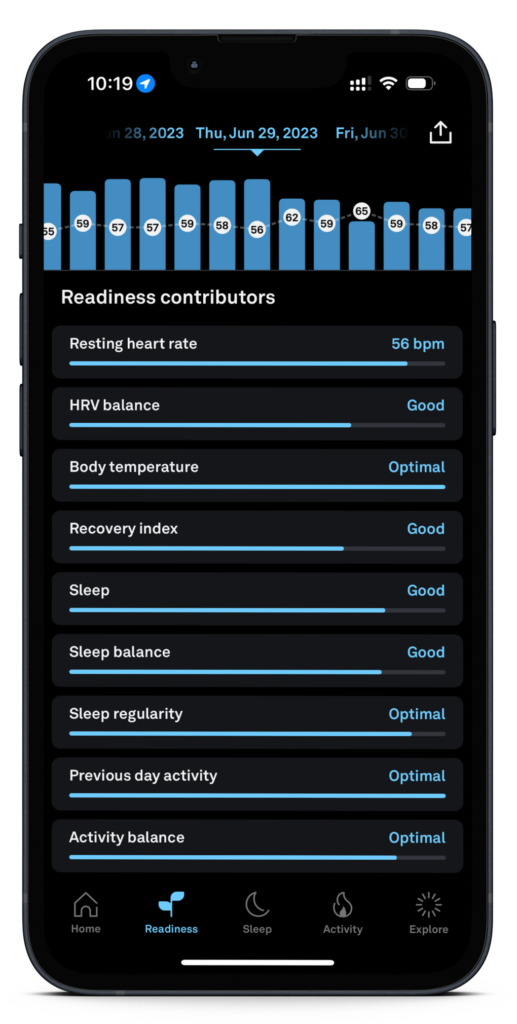
READ MORE: How Oura Members’ Readiness Scores Change Throughout The Week
More Readiness Tools
Beyond your Scores and Contributors, Oura provides more tools to investigate how ready your body is each day. At the top of your Readiness tab are 4 additional metrics — your average resting heart rate, heart rate variability, change in body temperature, and respiratory rate.
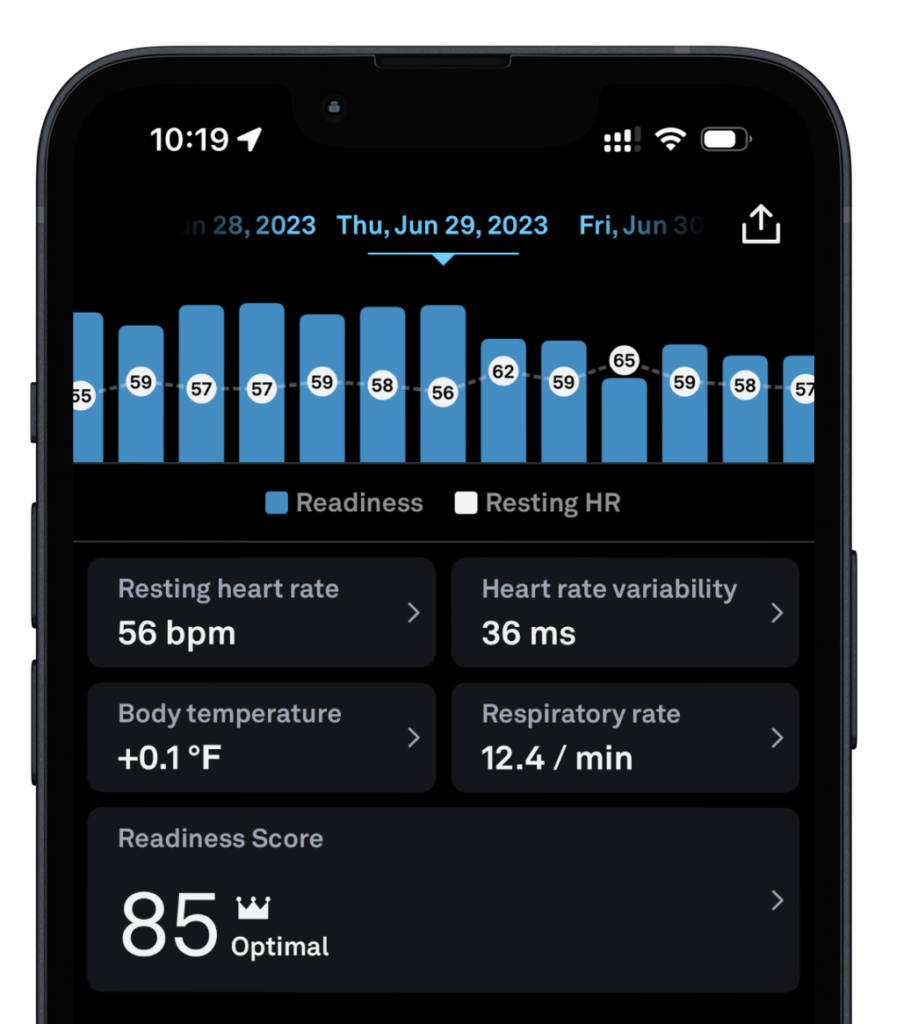
- Resting Heart Rate (RHR) is the number of times your heart beats per minute while at rest. A below-average resting heart rate is a signal of recovery.
- Heart Rate Variability (HRV) is an indicator of the variation between your heartbeats and is an indicator of your stress levels, recovery status, and general well-being. Read more.
- Body Temperature is the change in your nighttime skin temperature from your average which can act as an early signal of illness or hormonal fluctuations. Read more.
- Respiratory Rate is the number of breaths you take per minute while asleep. Respiratory rates may increase with illness or stress.
Scroll down the Readiness tab further, and you’ll find your nightly HRV and RHR graphs. Oura is the only wearable that gives you your entire night of HRV data and empowers you to look for recovery patterns in your nighttime heart rate graph.
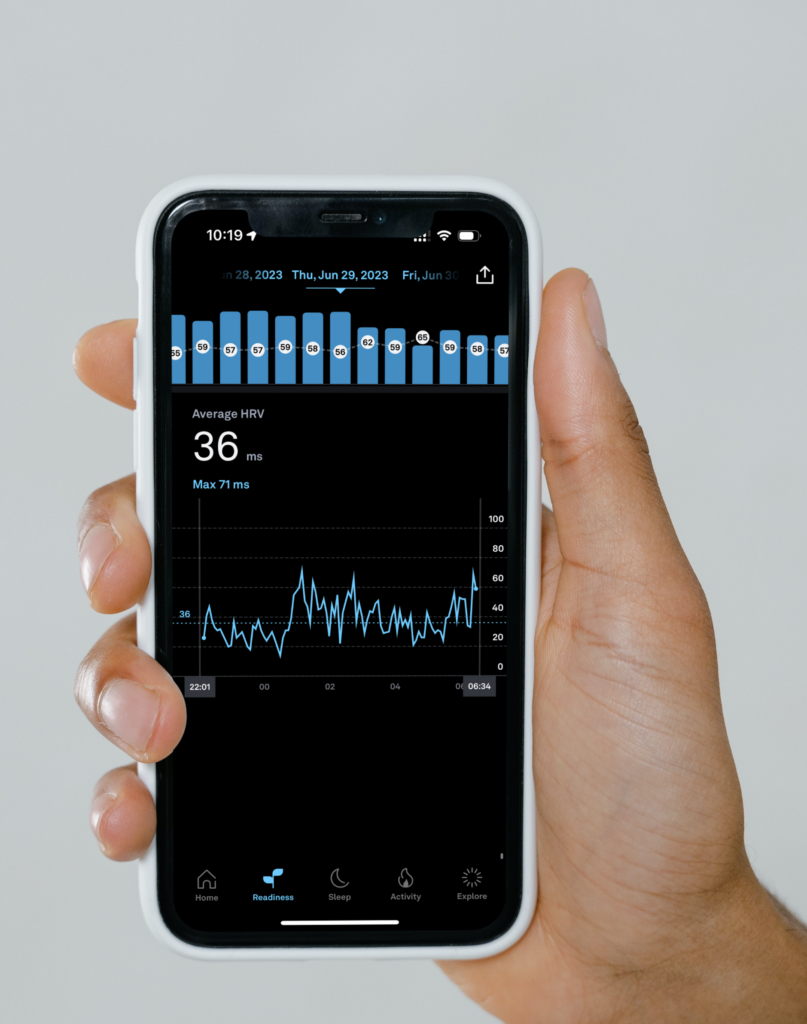
How To Improve Your Readiness Score
If you’re looking for ways to improve your Readiness Score, keep these principles in mind:
- Contributors where you receive a “pay attention” message with a red progress bar are areas for potential improvement.
- A Readiness Score of 85 or above is optimal. 100s are designed to be rare rather than regular.
- If an illness, injury, or lifestyle need prevents you from meeting your activity goals, you can temporarily mute your Activity Score & Contributors with Rest Mode.
As you’re exploring which Readiness Contributors you can improve, it helps to consider which questions they help you answer.
If your sleep contributors are in the red, try exploring whether it’s your short-term (Sleep) or long-term (Sleep Balance) contributors that need improvement. To improve these contributors, keep these tips in mind:
- Sleep: The quality of your previous night’s sleep significantly impacts your next day’s mental and physical performance. A Sleep Score above 85 will boost your Readiness Score. Try these tips for improving your sleep score.
- Sleep Balance: This contributor is a measure of your sleep debt. It analyzes whether your sleep over the past two weeks is in balance with your body’s needs and how much sleep you tend to get. To improve, aim for multiple nights of consistently good sleep when you can rather than “making up for lost sleep” on weekends or holidays.
If your activity contributors are in the red, try exploring whether your short-term (Previous Day Activity) or long-term (Activity Balance) contributors need improvement. To improve these contributors, keep these tips in mind:

- Previous Day Activity: Being unusually inactive or active the day before lowers your Readiness Score. If you’re struggling to stay active, check out these tips for improving your Activity Score. If you’re seeing your score dip because of high activity, keep in mind that Readiness signals a capacity that is meant to be used to achieve your goals. High levels of activity can be good for your health but may result in a temporary Readiness dip as your body rebounds. Find what works for you.
- Activity Balance: This measures how activity levels over the past 2 weeks may be affecting your readiness. For maximum performance, aim to maintain a good balance with your low, medium and high intensity activities. Your activity balance can drop temporarily during a peak training phase, but it should bounce back to normal as you recover. Staying in balance will boost your readiness and help you stay productive and healthy.
If your body’s stress contributors are in the red, your body may need rest and recovery. Oftentimes, these contributors are less about improving or aiming to hit a certain benchmark and more about being in touch with what your body needs. These insights may help:
- HRV Balance: This contributor compares your recent HRV to your long-term average. While individual days may be lower after high-intensity exercise, a night out, or a stressful day, if your HRV balance is on par with or better than your average, it’s a sign of good recovery. Read more.
- Body Temperature: Body temperature readings significantly above or below your normal range will lower your score. You can read more about how the Oura Community has used this to monitor for illness or to spot changes in pregnancy status and menstrual cycle phases.
- Recovery Index: This contributor captures how long it takes for your resting heart rate to stabilize during the night. If your resting heart rate approaches its lowest point during the first half of the night, this can be a good sign for recovery. If your heart rate remains high, try looking at what might be keeping it up – late meals, caffeine, exercise, stress or stimulation may be the culprit.
- Resting Heart Rate: Oura interprets a resting heart rate on par with your average as a sign that your mind and body are recovering well during sleep. An overly high or low resting heart rate may mean you’re overly stressed and not getting enough rest, or perhaps your immune system is fighting something. If your heart rate remains high, try looking at what might be keeping it up – late meals, caffeine, exercise, stress or stimulation may be the culprit.
RELATED: Your Oura Sleep Score










